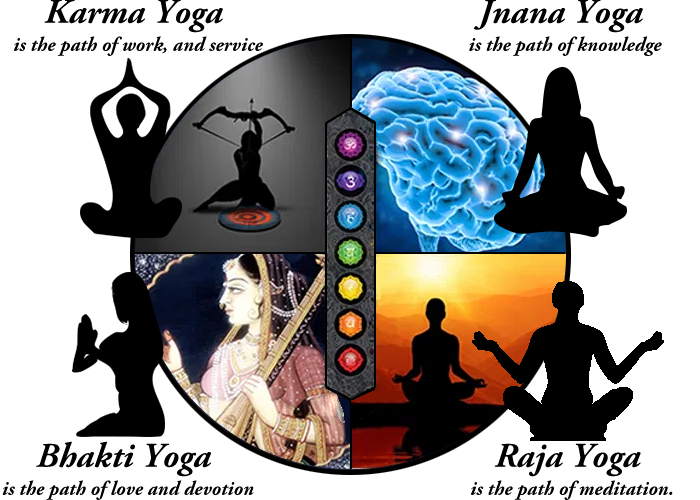| From ancient times,
people of the Indian subcontinent have practiced spiritual disciplines
designed to clear the mind and support a state of serene, detached
awareness. The practices for developing this desired state of balance, purity, wisdom, and peacefulness of mind are known collectively as yoga.
It means “yoke” or “union” — referring to
union with the true Self, the goal described in the Upanishads. While to many Westerners the term “yoga” may evoke images of stretches and poses for relaxation, the forms of yoga developed in India involve far more.
The sages distinguished four basic types of people and
developed yogic practices that are particularly suitable for each type,
in order that each can attain the desired union with the Self. For
meditative people, there is raja yoga, the path of mental concentration. For rational people, there is jnana yoga, the path of rational inquiry. For naturally active people, there is karma yoga, the path of right action. For emotional people, there is bhakti yoga, the path of devotion. (Living Religions, 89) |

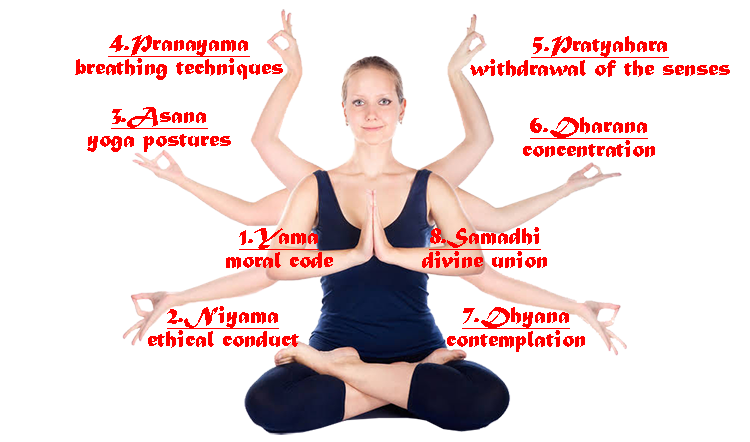
I. Raja Yoga
The “Royal”
Discipline
The term Raja Yoga refers to various systems (such as those described in Patanjali’s Yoga Sutras or the later system known as Kundalini) that focus on the use of techniques (including the
adoption of physical postures, breath control, mantras and
visualization)
to bring the mind to a state of one-pointed concentration, known as samadhi,
in which union with the absolute is attained.
Swami Sivananda defines samadhi as the super-conscious state of union with Brahman:
| Words
and language are imperfect to describe
this
exalted state. ... Mind, intellect and the senses cease functioning. ... It is
a
state of eternal Bliss and eternal Wisdom. All dualities vanish in
toto. ... All visible merge in the invisible or the Unseen. The
individual
soul becomes that which he contemplates. (Living Religions, 90) |
Do you think that it is possible to attain union with Brahman/God?
Why or why not?
|

The path of rational inquiry — jnana yoga —
employs the rational mind rather than trying to transcend it by
concentration practices. In this path, ignorance is considered the root
of all problems. Our basic ignorance is our idea of our selves as being
separate from the Absolute. One method is continually to ask, “Who am
I?” The seeker discovers that the one who asks the question is not the
body, not the senses, not the mind, but something eternal beyond all
these. The guru Maharshi explains:
After
negating [one’s identity with
the
body, the senses, and the mind] as “not this,” “not this,”
that
Awareness which alone remains — that I am. ...
The thought “Who am I?” will
destroy
all other thoughts, and, like the stick used for stirring the burning
pyre, it will itself in the end get destroyed. Then, there will
arise Self-realization. (Living Religions, 91)
|

In
contrast to [the] ascetic and contemplative practices [of Raja Yoga and
Jnana Yoga], another way is that of helpful action in the world. Karma
yoga is service rendered without any interest in its fruits or results
and without any personal sense of giving. The yogi knows that the
Absolute performs all actions, and all actions are gifts to the
Absolute. This consciousness leads to liberation from the self in the
very midst of work. (Living Religions, 91)
 |
|
The Bhagavad Gita
Chapter 3
4. A man does not go beyond action by merely avoiding action, nor does he achieve spiritual success by renunciation alone.
5. For no one exists even for a moment without performing actions. Even
if unwillingly, every one of us must act, due to the forces of nature.
19. Therefore, continue to do any action that you
are obliged to do, but always without attachment. By continuing to act
without attachment, a man attains the highest good.
30. Surrender all your actions to me, and fix
your mind on your inmost self. Become free from desire and
possessiveness. Cast off this fever and fight!
31. Men who always follow this teaching of mine, confident in it and not disputing it, are freed from their actions.
32. But know that those who dispute my teaching and do not follow it —
they misunderstand all knowledge, they are senseless, they are lost!
35. One’s own duty done poorly is better than
another’s duty done well. It is better to die engaged in one’s own
duty. Taking on another’s duty is dangerous. (Bhagavad Gita, 16-19)
|

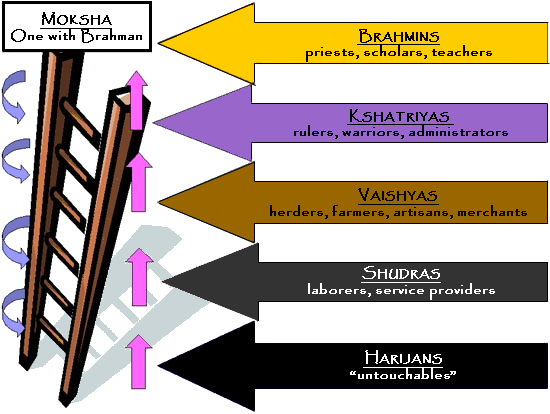
At the heart of Karma Yoga is the varnasrama-dharma system, which focuses on the performance of
actions in
accordance with the duties (dharma) associated with one’s caste (varna)
and stage of life (asrama). By acting in accordance with
the
principles of varnasrama-dharma,
one gradually works through
the
four stages of life (student, householder, forest-dweller, renunciate)
and four modes of rebirth (shudra, vaishya, kshatriya, and brahmin)
towards
ultimate release from the cycle of rebirth (moksha).
For
the sake of the preservation of this entire creation, [Purusha], the
exceedingly resplendent one, assigned separate duties to the classes
which had sprung from his mouth, arms, thighs, and feet.
 |
Teaching, studying,
performing sacrificial rites, so too making others perform sacrificial
rites,
and giving away and receiving gifts — these he assigned to the brahmans. |
|
|
Protection of the
people, giving away of wealth, performance of sacrificial rites,
study,
and nonattachment to sensual pleasures — these are, in short,
the duties
of a kshatriya. |
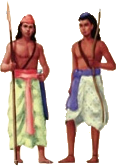 |
 |
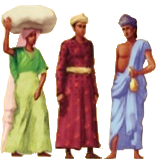 |
Tending of cattle,
giving away of wealth, performance of sacrificial rites,
study, trade
and commerce, usury, and agriculture — these are the
occupations of a vaishya. |
 |
The Lord has
prescribed only one occupation for a shudra,
namely, service without
malice of even these other three classes.
|
 |
|
 The Four Stages of Life The Four Stages of Life
Ashramas
The
process of attaining spiritual realization or liberation is thought to
take at least a lifetime, and probably many lifetimes. Birth as a human
being is prized as a chance to advance toward spiritual perfection. In
the past, spirtual training was usually available to upper-caste males
only; women and shudras were
excluded. Spirtual training for men has historically been preceded by
an initiation ceremony in which the boy received the sacred thread, a cord of three threads to be worn across the chest from the left shoulder.
A Brahmin male’s lifespan was ideally divided into four periods of
approximately twenty-five years each. For the first twenty-five years
he is a chaste student at the feet of a teacher. Next comes the
householder stage, during which he is expected to marry, raise a
family, and contribute productively to society. After this period, he
starts to detach himself from worldly pursuits and to turn to
meditation and scriptural study. By the age of seventy-five, he is able
to withdraw from society and become a sannyasin. (Living Religions, 97) |
 IV. Bhakti Yoga
IV. Bhakti Yoga
As
with the other three disciplines, Bhakti Yoga is based on the
fundamental Upanishadic insight, namely the identity of the individual
soul (atman) and the
Universal Soul (Brahman). However, while the paths of “wisdom” (Jnana
Yoga) and “meditation” (Raja Yoga) require intense effort, and the path
of “action” (Karma Yoga) ultimately requires relinquishing all
attachment to the self, Bhakti Yoga relies only on devotion to a chosen
deity. In the Bhagavad-Gita, Krishna presents this devotional approach as the ideal path to liberation from the cycle of rebirth (moksha), for it is open to all (regardless of caste or gender) and requires only that the devotee (bhakta) perform all actions in a spirit of service to God.
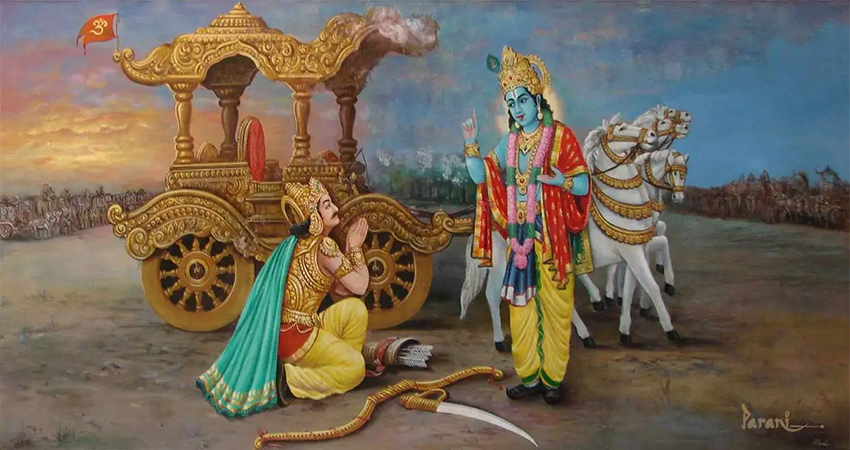 |
I
pervade the entire universe in my unmanifested form. All creatures find
their existence in me, but I am not limited by them. Behold my divine
mystery! ... The foolish do not look beyond physical appearances to see my true
nature as the Lord of all creation. The knowledge of such deluded
people is empty; their lives are fraught with disaster and evil and
their work and hopes are all in vain. But truly great souls seek my divine nature.
They worship me with a one-pointed mind, having realized that I am the
eternal source of all. Constantly striving, they make firm their
resolve and worship me without wavering. Full of devotion, they sing of
my divine glory. ...
Whatever I am offered in devotion with a pure heart — a leaf, a flower, fruit, or water — I partake of that love offering. Whatever you do, make it an offering to me — the
food you eat, the sacrifices you make, the help you give, even your
suffering. In this way you will be freed from the bondage of karma,
and from its results both pleasant and painful. Then, firm in
renunciation and yoga, with your heart free, you will come to me.
I look upon all creatures equally; none are
less dear to me and none more dear. But those who worship me with love
live in me, and I come to life in them. ... All those who take refuge in
me, whatever their birth, race, sex, or caste, will attain the supreme
goal; this realization can be attained even by those whom society
scorns. ... Therefore, having been born in this transient and forlorn
world, give all your love to me. Fill your mind with me; love me; serve
me; worship me always. Seeking me in your heart, you will at last be
united with me. (Anthology of Living Religions, 66-8 [Bhagavad Gita, Chapter 9]; cf. BG/9)
|
 Although the Four Yogas
are not mutually exclusive, most Hindus focus primarily on the path
of devotion to a personal deity, such as Krishna, Vishnu, Shiva, Durga, or Kali. Such devotion is
manifest
as an intense feeling of love for God that is frequently expressed
through
poetry and song, such as the following offering from Mirabai:

|
Everything perishes,
sun, moon, earth, sky, water, wind,
everything.
Only the One Indestructible remains.
Others get drunk on distilled wine,
in love’s still I distil mine;
day and night I’m drunk on it
in my Lover’s love, ever sunk ...
I’ll not remain in my mother’s home,
I’ll stay with Krishna alone;
He’s my Husband
and my Lover,
and my mind is
at his feet forever.
|
|
 |
|

Since Bhakti Yoga is more easily pursued than either
Raja
or Jnana
Yoga, it is by far the most common form of Hindu practice. Its
appeal
is nicely expressed in the following quote from Ramakrishna:
| As long as the I-sense lasts, so long are
true
knowledge
and Liberation impossible. … [But] how very few can obtain this Union
[Samadhi]
and free themselves from this “I”? It is very rarely possible.
Talk
as much as you want, isolate yourself continuously, still this “I” will
always
return to you. Cut down the poplar tree today, and you will find
tomorrow
it forms new shoots. When you ultimately find that this “I”
cannot
be destroyed, let it remain as “I” the servant. (Living Religions, 93) |
How
is Hindu devotional worship similar to and/or different from the
devotional practices of the tradition with which you are most familiar?

|
